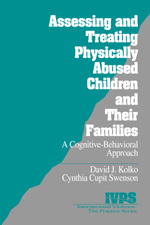D. Wolfe
Foreword
Acknowledgments
1. Introduction and Overview
Significance of the Problem
Purpose and Overview of the Book
2. Characteristics and Correlates of Child Physical Abuse
Child Characteristics and Correlates
Maltreating Adult Characteristics and Correlates
Family-System Characteristics and Correlates
Community Characteristics and Correlates
What Causes Child Physical Abuse
3. Treatment Outcome Studies: Clinical and Research Implications
What Do We Need to Learn in Research to Make Treatment More Effective?
What Would Make Clinical Practice More Effective?
5. The Comprehensive Individual and Family Cognitive-Behavioral Treatment Model
Models of Child Physical Abuse
The Integration of Child, Parent, and Family Approaches
6. Initial Treatment Considerations
Preparation and Prerequisites
7. Treatment of the Child: Understanding the Child's Experiences and Behavior
Perspectives on the Child's Experiences With Family Hostility and Violence
Contributors to Coercive or Abusive Interactions
Understanding How We Respond to Different Problem Situations
8. Treatment of the Child: Cognitive Interventions
Clarifying and Changing the Child's View of Violence
Normalization of the Child's Abuse-Related Feelings and Reactions
Psychoeducation About Physical Abuse
9. Child Treatment: Affect-Focused Interventions
Affect Identification and Expression
Management of Stress and Anxiety
10. Promoting Children's Effective Coping and Social Competence
Enhancing Children's Social Competence and Developing Relationships: : Getting Along With Friends and Family
11. Adult Treatment: Cognitive Interventions
Parental Perspectives on Violence, Expectations, and Distortions
Stress Management and Family Characteristics
Views on Hostility and Violence
Expectations of Our Children
Thinking in Negative or "Distorted" Ways
12. Treatment of the Maltreating Adult: Affect-Focused Interventions
Self-Management and Regulation of Abuse-Specific Triggers
Self-Management and Regulation of Anger
Self-Management and Regulation of Anxiety and Posttraumatic Stress Disorder
Self-Management and Regulation of Depression
13. Treatment of the Maltreating Adult: Behavior Management
Parenting and Behavior Management
Specific Techniques and Guidelines for Rewarding Behavior
Specific Techniques and Guidelines for Punishing Behavior
A General Review of Behavior Management
14. From Individual to Family Treatment: Bridging Through Clarification
The General Structure of Clarification
The Clarification Family Meeting
15. Family Treatment: Setting the Foundation
Assessment of Family Functions and Interactions
16. Family Treatment: Skills Training and Applications
Review of Initial Progress
Family Skills-Training Applications
17. Community and Social Systems Involvement
Service Settings and Systems
18. Case Examples and Applications
19. Conclusions
Index
About the Authors

